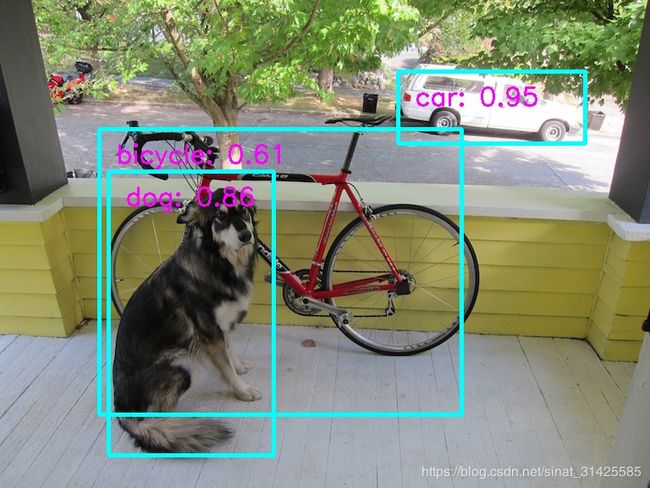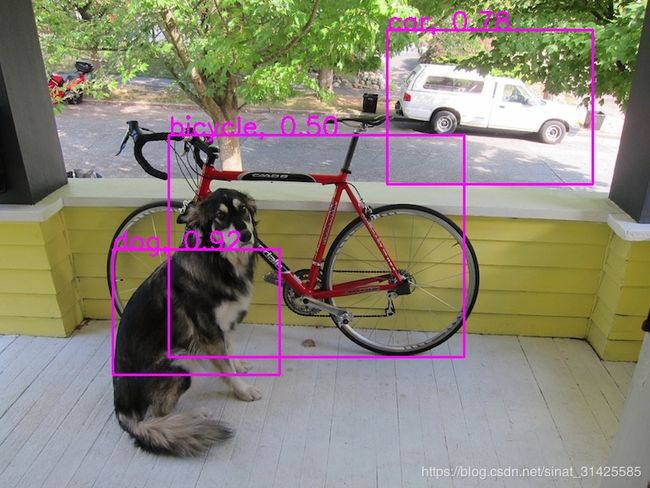tvm 学习笔记(四):tvm量化pytorch的onnx模型
1、模型来源:
github链接:https://github.com/qfgaohao/pytorch-ssd
2、保存成onnx模型
运行convert_to_caffe2_models.py脚本
>> python convert_to_caffe2_models.py3、使用onnx-simplifier工具:
安装使用:
>> pip3 install onnx-simplifier
>> python3 -m onnxsim input_model output_model4、模型转换
import onnx
import numpy as np
import tvm
import tvm.relay as relay
import tvm.relay.testing
from tvm import autotvm
from tvm.contrib import graph_runtime
import sys
target = tvm.target.create('llvm')
onnx_model = onnx.load('ssd.onnx')
input_name = '0' # change '1' to '0'
shape_dict = {input_name: (1, 3, 300, 300)}
sym, params = relay.frontend.from_onnx(onnx_model, shape_dict)
with relay.quantize.qconfig(skip_k_conv=0, round_for_shift=True):
sym = relay.quantize.quantize(sym, params)
with relay.build_config(opt_level=1):
graph, lib, params = relay.build_module.build(sym, target, params=params)
dtype = 'float32'
print("Output model files")
libpath = "./ssd.so"
lib.export_library(libpath)
graph_json_path = "./ssd.json"
with open(graph_json_path, 'w') as fo:
fo.write(graph)
param_path = "./ssd.params"
with open(param_path, 'wb') as fo:
fo.write(relay.save_param_dict(params))
5、模型部署
#!/usr/bin/python3
import os
import tvm
import numpy as np
import time
from tvm.contrib.download import download
from tvm.contrib import graph_runtime
import cv2 as cv
from util.process import preprocess, non_maximum_suppression
class_names = ["background", "aeroplane", "bicycle", "bird", "boat", "bottle", "bus", "car", "cat", "chair",
"cow", "diningtable", "dog", "horse", "motorbike", "person", "pottedplant",
"sheep", "sofa", "train", "tvmonitor"]
test_json = 'ssd.json'
test_lib = 'ssd.so'
test_param = 'ssd.params'
loaded_json = open(test_json).read()
loaded_lib = tvm.module.load(test_lib)
loaded_params = bytearray(open(test_param, "rb").read())
dshape = (1, 3, 300, 300)
dtype = "float32"
ctx = tvm.cpu(0)
module = graph_runtime.create(loaded_json, loaded_lib, ctx)
module.load_params(loaded_params)
test_image_path = 'dog.jpg'
img_src = cv.imread(test_image_path)
height, width, _ = img_src.shape
img_input = preprocess(img_src)
# run the module
module.set_input("0", img_input)
module.run()
tvm_out_prob = module.get_output(0).asnumpy()
tvm_out_loc = module.get_output(1).asnumpy()
scores = tvm_out_prob[0]
boxes = tvm_out_loc[0]
picked_box_probs = []
picked_labels = []
# each time get one column
for class_index in range(1, scores.shape[1]):
probs = scores[:, class_index]
mask = probs > 0.4
probs = probs[mask]
if probs.shape[0] == 0:
continue
subset_boxes = boxes[mask, :]
# condate to a N x 5 matrix
boxes_probs = np.concatenate([subset_boxes, probs.reshape(-1, 1)], 1)
boxes_probs = non_maximum_suppression(boxes_probs, 0.45)
picked_box_probs.append(boxes_probs)
picked_labels.extend([class_index] * boxes_probs.shape[0])
picked_box_probs = np.concatenate(picked_box_probs)
picked_box_probs[:, 0] *= width
picked_box_probs[:, 1] *= height
picked_box_probs[:, 2] *= width
picked_box_probs[:, 3] *= height
for box_prob, label_index in zip(picked_box_probs, picked_labels):
cv.rectangle(img_src, (box_prob[0], box_prob[1]), (box_prob[2], box_prob[3]), (255, 0, 255), 2)
label = "{}, {:.2f}".format(class_names[label_index], box_prob[4])
cv.putText(img_src, label,
(box_prob[0], box_prob[1]),
cv.FONT_HERSHEY_SIMPLEX,
1,
(255, 0, 255),
2)
path = "output.jpg"
cv.imwrite(path, img_src)
print("write image successed.")
原始效果:
量化后效果:
效果感觉有点渣,可能有什么误会,我再研究一下~
参考资料:
https://github.com/qfgaohao/pytorch-ssd

